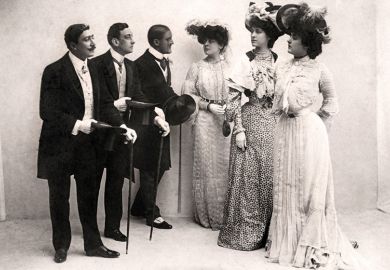“Mostly straight” is a new sexual category and a developmental psychologist is playing a central role in its formation. Ritch Savin-Williams’ guide is both a chatty summary of interviews and a self-help book calling on the not-totally-heterosexual to come out of the closet – yes, closet. “Starting now, let’s purge young men from the murky landscape of the sexual neverlands [his emphasis], the invisible land that once existed between heterosexuality and bisexuality.” Mostly straight men are predominantly heterosexual (they desire and have sex with women) but are open to the possibility of same-sex attraction and sexual contact.
Although the “mostly straight” are claimed as “sexually fluid” and challenging to the dominant categories of heterosexual, homosexual and bisexual, the reader is entitled to ask how radical the category really is. Its psychologist writes of a “very diverse group”, but his sample is predominantly white, middle class, college-educated and young (teens and early twenties). There are few African American, Asian or Hispanic mostly straight informants. The cohort is entirely male too in this study; Lisa Diamond, Savin-Williams and others have already established female sexual fluidity.
Trans is not a sexuality, of course, but it is not mentioned in any of the book’s rather depressingly conventional discussions of gender. The old stereotype of effeminacy and homosexuality lingers; masculinity is constantly asserted in the descriptions of young heterosexuals. But the striking characteristic of this supposed sexual fluidity is that there is little or no adult, physical, gay sex in these (short) histories, “actual sex with a guy”. These are identities without acts. The mostly straight are very straight. Arguably, such straightness reinforces rather than challenges heterosexual normativity.
As formulated in this account, “mostly straight” is a category without a history. Apart from references to Alfred Kinsey, Savin-Williams demonstrates little historical awareness, believing that heterosexuality has always existed, and is seemingly oblivious to earlier histories of sexual fluidity where heterosexual men would engage in same-sex sex without compromising either their masculinity or their heterosexuality.
Is this “new kid on the block” any advance on Kinsey’s famous seven-point sexual flexibility scale of the 1940s? This ranges from zero (for exclusive heterosexuality) to six (for total homosexuality), but allows for a substantial section of the population to be ranked from one to five. It is a scale still used in online surveys because it accommodates postmodern sexual plasticity. Indeed, Savin-Williams suggests that the mostly straight rank between zero and one on the Kinsey scale. Alternatively, the new classification could be superseded before it even takes hold. Recent surveys have discovered flexibility in sexual orientation, with many of those surveyed choosing “other” or scores of different descriptors instead of gay, lesbian, heterosexual or bisexual when asked to self--classify.
Is “mostly straight” even a sexuality, the “unique sexual identity” claimed by its champion? It is the orientation of young men who are comfortable in their heterosexuality, unthreatened by alternative sexualities, who have experienced intense male friendships and are capable of appreciating male beauty. Thus, it represents a tolerant and progressive heterosexuality that should be encouraged yet need not be taxonomised.
Barry Reay is professor of history at the University of Auckland and the author of New York Hustlers (2010), which discusses sexual fluidity among American men in the decades before the late 1960s.
Mostly Straight: Sexual Fluidity Among Men
By Ritch C. Savin-Williams
Harvard University Press, 256pp, £22.95
ISBN 9780674976382
Published 24 November 2017
Register to continue
Why register?
- Registration is free and only takes a moment
- Once registered, you can read 3 articles a month
- Sign up for our newsletter
Subscribe
Or subscribe for unlimited access to:
- Unlimited access to news, views, insights & reviews
- Digital editions
- Digital access to THE’s university and college rankings analysis
Already registered or a current subscriber?







